The Apparition of Our Lady at Caravaggio
May 26, 1432, Caravaggio, Bergamo, Italy
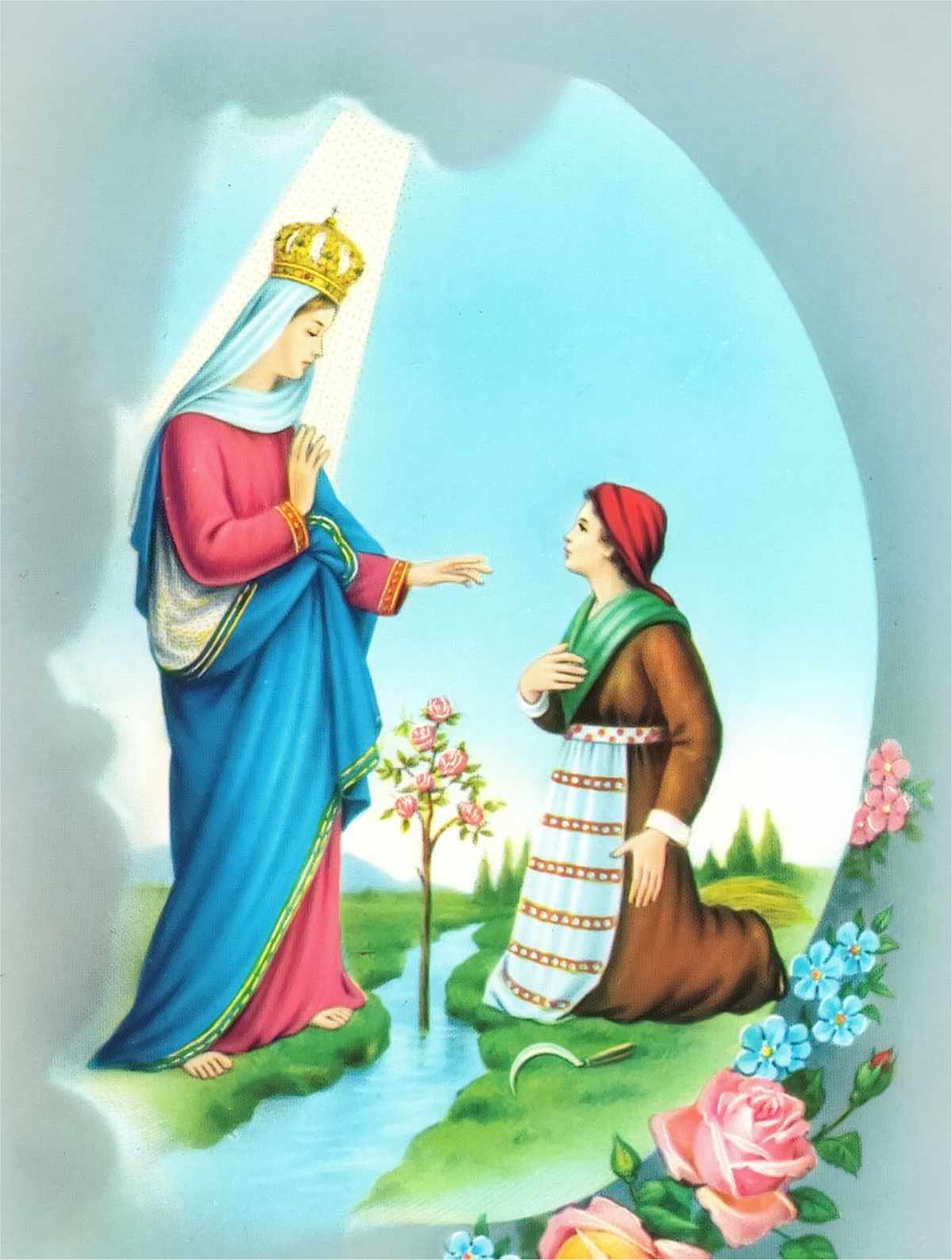
The Apparition and its Message
God rich in mercy and omnipotent, who by His providence disposes all things suavely, out of that piety which never leaves any faithful bereft of His heavenly help one day was pleased to regard, succor and even honor the people of Caravaggio with the Apparition of the Virgin Mother of God.
In the year from the birth of the Lord, on the day May 26 at five o'clock in the evening, it happened that a woman named Giannetta from the village of Caravaggio, 32 years of age, daughter of Pietro Vacchie and spouse of Francesco Varoli, known by all for her virtuous manners, her Christian piety, and her sincerely honest life, was outside the village along the road to Misano, and she was all caught up in the thought of how she could bring home the bundles of grass that she had come to mow for her animals.
When lo and behold she saw coming from above and stopping right next to her, a beautiful and admirable Lady, of majestic stature, of graceful face, of venerable appearance and beauty unspeakable and never imagined, dressed in a blue dress and Her head covered with a white veil.
Impressed by such venerable appearance of the noble Lady, astonished Giannetta exclaimed: "Virgin Mary!"
And the Lady immediately said to her: "Fear not, daughter, for it is indeed I. Stop and kneel in prayer."
Giannetta replied: "Lady, I have no time now. My horses are waiting for this grass."
Then the most blessed Virgin spoke to her again: "Now do what I want of you...."
And so saying She laid Her hand on Giannetta's shoulder and brought her to her knees. She resumed: "Listen well and keep in mind, for I want you to report wherever you can with your mouth or make you say this..."
And with tears in Her eyes, which according to Giannetta's testimony seemed like glittering gold, She added:
"The Most High Almighty My Son intended to annihilate this earth because of the iniquity of men, because they do what is evil more and more every day, and fall from sin to sin. But I for seven years have pleaded with My Son for mercy for their sins. Therefore I want you to tell each and every one that they should fast on bread and water every Friday in honor of My Son, and after vespers, out of devotion to Me they should celebrate every Saturday."
"That half-day they should dedicate it to Me in gratitude for the many and great favors obtained by My Son through My intercession."
The Virgin Lady said all those words with open hands and as if afflicted. Giannetta said: "People will not believe me."
The most clement Virgin answered: "Arise, do not be afraid. You report what I have commanded you. I will confirm your words with such great signs that no one will doubt that you have spoken the truth."
Having said this, and made the sign of the cross over Giannetta, She disappeared from her sight.
Immediately returning to Caravaggio, Giannetta reported all that she had seen and heard. Therefore many - believing her - began to visit that place, and found there a spring never before seen by anyone.
To that spring then went some sick people, and thereafter in increasing numbers, trusting in the power of God. And the news spread that the sick came back freed from the infirmities from which they were suffering, through the intercession and merits of the most glorious Virgin Mother of God and our Lord Jesus Christ.
To Him, the Father and the Holy Spirit be praise and glory always for the salvation of the faithful. Amen.
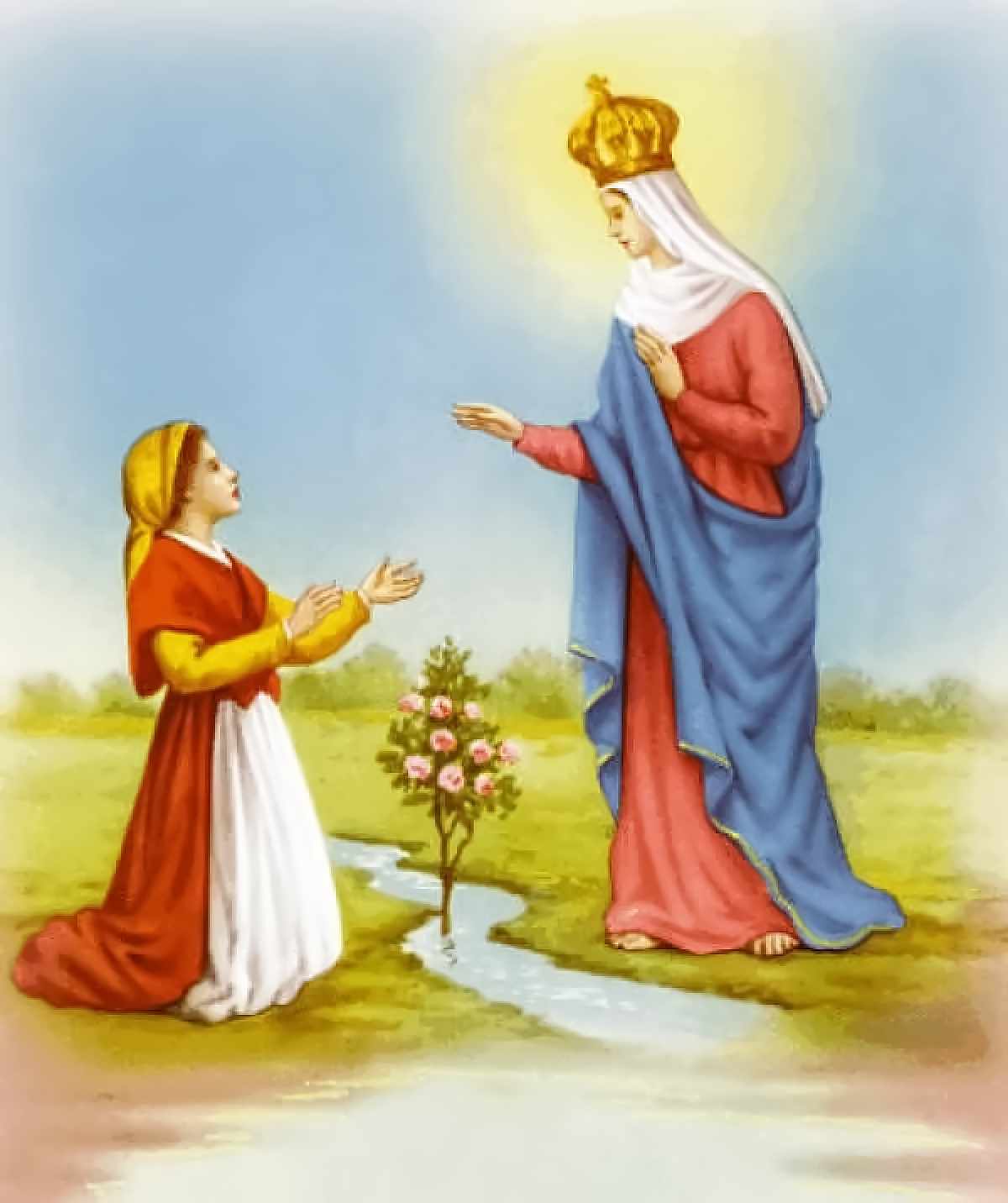
The Tears in Her Eyes, Her Hands Open As If Afflicted
The weeping of the Madonna in Caravaggio, as well as the message on which one must instead meditate at length, has almost never been emphasized. Yet Giannetta had caught, impressed, those tears and that affliction of the Mother of Christ: the Madonna speaks with tears in her eyes. It is true that they look like glittering gold to her, but it is because they cannot fail to strike her. With open hands and as if afflicted, the Virgin confides her sorrow and at the same time her interceding compassion to Giannetta. The Virgin's sorrow is the sorrow of her Son, provoked even to the threat of punishment for the sins of men as in the Gospel: "...if you do not do penance, you will all perish in the same way" (Lk 13:3, 5).
And there was reason, if we think of those years of troubled history for the Church and the violence of the time perpetrated in Caravaggio's own land.
For the political situation in the territory of Gera d'Adda, it should be remembered that hostilities between the Venetian republic and the Duchy of Milan had been rekindled since early 1431. Caravaggio would constitute as a crucial junction of these for not a few years throughout the 15th century. Between 1432 and 1441, between 1448 and 1453 Caravaggio went to and fro under the rule of Milan and Venice, and was made the scene of battles, truces, negotiations of "chapters" on either side that would allow its inhabitants to survive. The peace, the paci, were precarious. The Gera d'Adda would remain with Milan in relative peace until 1499. Then for another ten years or so it would return under Venice.
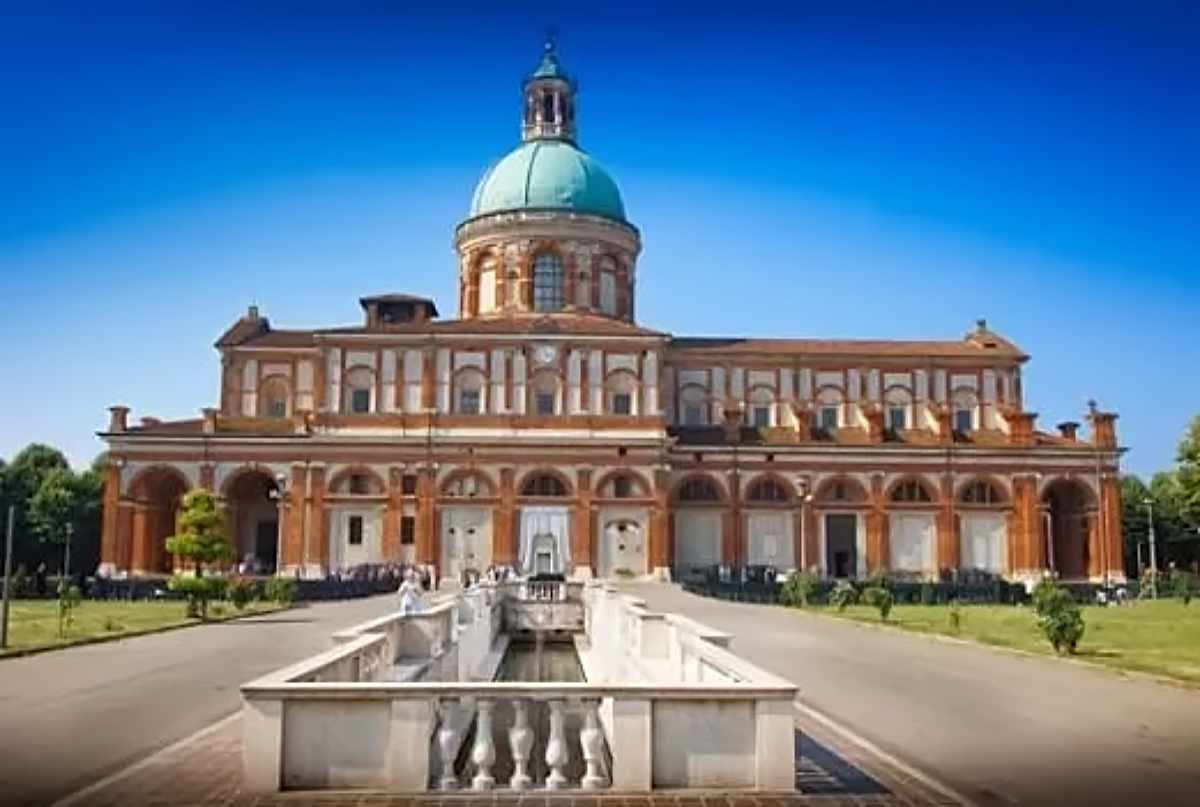
The Sanctuary with Source
A Source Never Seen Before
"Our Lady of the Fountain" is referred to today as the Caravaggio Shrine. For many centuries, however, the place and the Church of the Apparition were referred to as "Santa Maria alla fontana." And this way of writing had a precise reason.
The Mazzolengo meadow was part of a vast countryside surrounding Caravaggio and was certainly not in an "uncultivated arid and wild place...knowing most certainly that here there was neither fountain nor other spring of water," as Paolo Morigi, a historian of the time, begins to write in his 1599 Historia. The denial comes from the report of the representatives of Caravaggio transposed in the "lettere patenti" of Antonio Aleardi, vicar general of Bishop Venturino: Our Lady appears in a place called Mazzolengo where there had always been and still is a fountain; she appears just "near" (prope fontem) it so that the place turns out to be well identified, at a distance of a few dozen steps.
The people of Caravaggio knew that on the road to Misano in the countryside "al Mazzolengo" there is a large, well-identified spring and that those lands, like many others in the area, are rich in springs.
Giannetta mows her grass on those lands but where Our Lady appears to her on that day there is no spring nor can be seen. That is why people who flock there are given to find "a spring they have never seen before." And only because those who bathe in that water are healed of their ills will that spring become "the holy spring." And only because the legendary unbeliever who throws dry wood into it in the hope that somehow certain proof or disproof of the asserted Apparition will come (like Thomas the apostle: "...unless I see...unless I touch with my hands...I will not believe") sees it transformed into a flowering sapling, that spring will certify to him as "the fountain of miracles."
But how will one point out, to those who run to see, where Our Lady appeared? One will say, "at the fountain." We, however, must make it clear that the fifteenth-century vernacular also reported in official Latin documents Santa Maria alla fontana is to be read as the Latin of origin demands that it be translated; namely, to let us know that the church of Santa Maria is located by going on the road to Misano to the Mazzolengo meadow near (ad) a spring. This reading clears without any forcing, indeed on the sure basis of the configuration of the places, any claim or alleged contradiction in the narratives of the May 26 event about ... two sources.
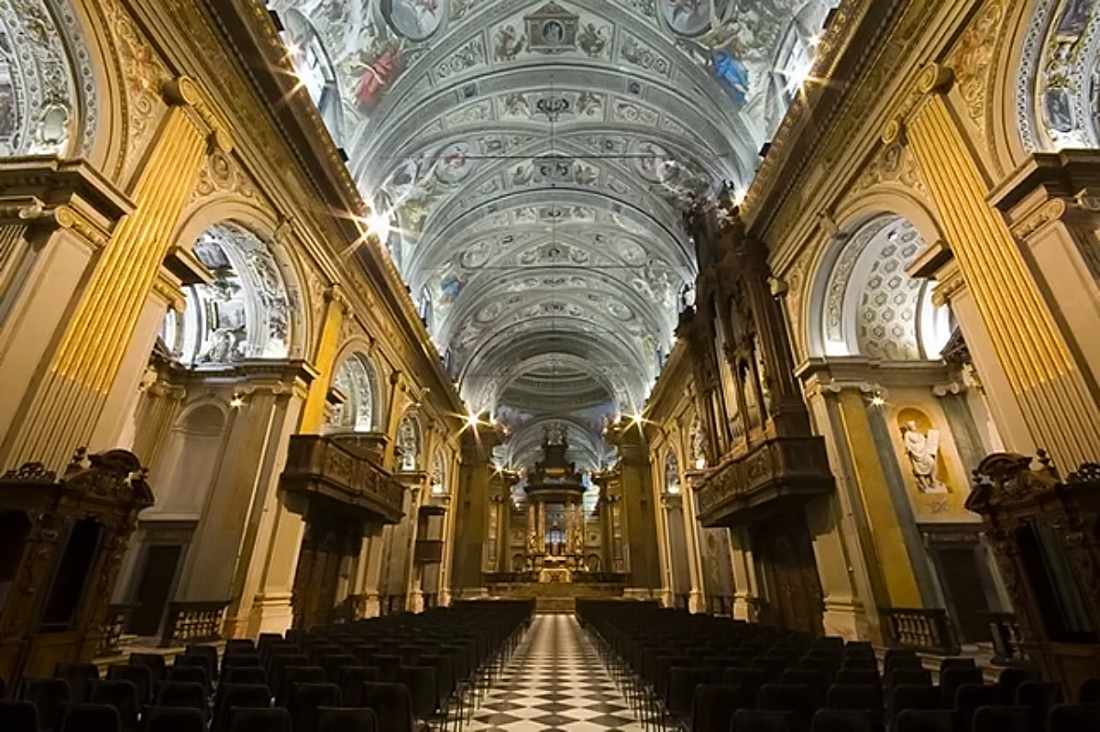
Interior of the Sanctuary
The Sign of Water and the Gospel
In its own way the fountain of miracles makes present, here and now the Gospel. This was well understood from the very beginning by the ancient witnesses who "recorded" the healings with Gospel phraseology: "Adi above (August 10, 1432). Stefano, son of Gabriello di Zenalij di Trevì (Treviglio), aged four years, never had the use of going, as his mother testified, but immediately after he was washed in the Fountain he walked with his feet alone without any other support.
The sign of water accompanies the history of the people of the Old and New Covenants and characterizes many Shrines where the Mother of Jesus appeared. Not for nothing was Her presence "decisive" when Christ performed the first of His signs by changing water into wine. Through water He also worked healings of body and spirit. The sin of the world is washed away by the water and blood that flowed from His pierced Heart, and by the gift of the Spirit, those reborn in the water of baptism are generated to new life.
When the sick are brought to the Shrine's forecourts and made to pass by the Sacred Fountain praying for their healing; when crowds flock to this place in pilgrimage to draw from the springs of grace as soon as material; when devotion drives the people of the faithful to ask "anything" of Jesus, interposing the intercession of the Blessed Mother (. ... "They have no more wine"!) with the confidence that He will do it, can it be said that we condescend to sentimental and non-rational forms of faith and barely take refuge in a consolatory type of prayer?
Here Jesus still passes through the midst of humanity, working "by the power of the Spirit" in the spring of living water, ever living even as he is mysteriously present under the Eucharistic sign.
And when graces of conversion of hearts and healing from physical infirmities occur at the crowd's encounter with Him, it is still through the signs and mediations of Christ's incarnation, again and in continuation of the "year of the Lord's grace" that the possibility of approaching and attaining, in the Lord Jesus, the unique gift of God's grace is offered.
The sign of water, however, in addition to confirming the credibility of Giannetta's attestation, is an expression of the healing power of God's grace, which works through Mary's intercession after her appearance.
"People will not believe me," said Giannetta.
But the most clement Virgin answered, "Arise, do not fear. You report what I have commanded you; I will confirm your words with such great signs that no one will doubt that you have spoken the truth." ... And having made the sign of the cross over Giannetta, She disappeared in her eyes."
So again the text of the ancient account reports. The "signs so great" that confirmed the message: are thus the source never before seen by anyone; the sick delivered from the infirmities from which they suffered.
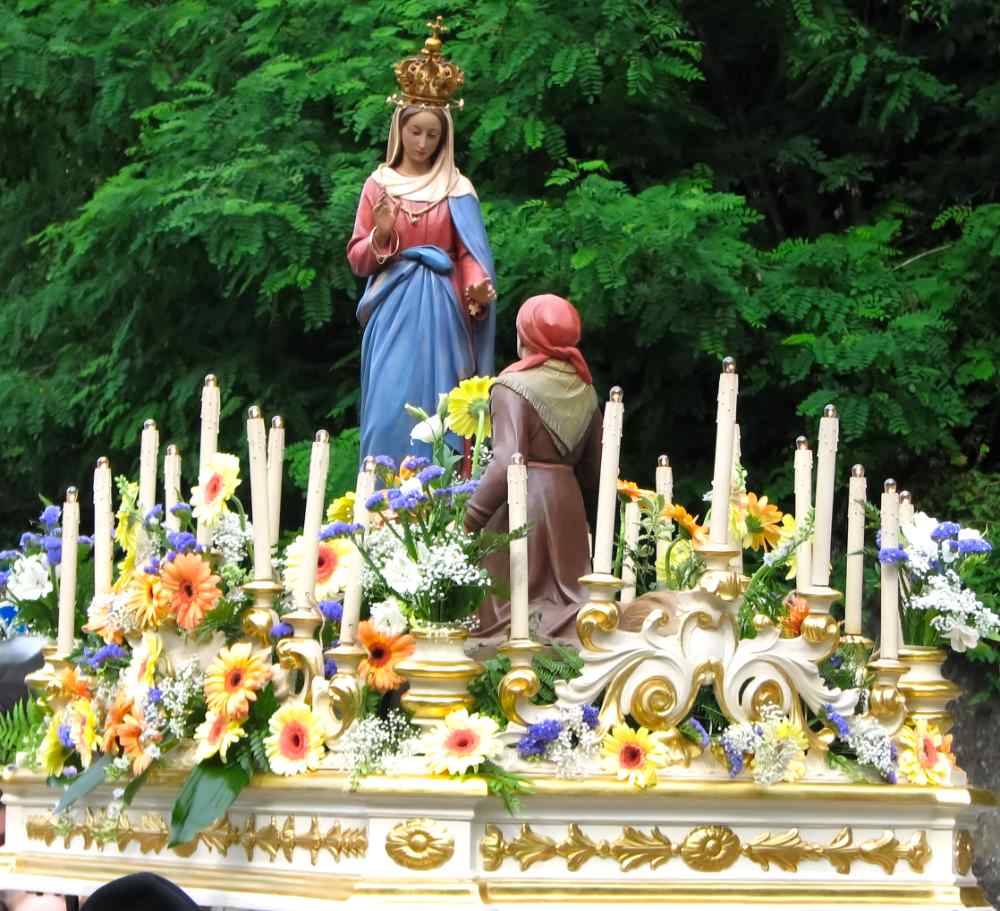
Procession with Scene of the Apparition
Gospel Call to Conversion
While they have always been variously illustrated, the history and traditions, devotions and art that have made the Shrine of Caravaggio famous over the centuries as surprising as it may seem, the message of the Apparition is almost completely ignored and moreover has continued to remain without comment.
It is true that it has been conveyed to us in a form and literary genre that are no longer of our culture, even theological culture. But the strange fact is that even in the past centuries the attention and devotion aroused by the event of May 26, 1432 seems to have polarized more on the "fountain of miracles" than on Our Lady's words to Giannetta.
What words? Let us hear them again in a translation as faithful as possible to the text of the ancient "authorized" account handed down to us from the acts of Bishop Speciano's pastoral visit:
"Listen well and remember. I want you to report wherever you can, or cause to be told, this: the Most High Almighty My Son intended to annihilate this earth because of the iniquity of men. They do what is evil more and more every day, and they fall from sin to sin. But for seven years I have pleaded with My Son for mercy for their sins. Therefore I want you to tell each and every one that they should fast on bread and water every Friday in honor of My Son...."
Beyond the verbal covering and expressions used, the message in its essentiality is the same - after all, it could not be anything else - that resonates from the Old Testament to the New Testament, from one prophetic witness to another concentrated in Jesus' call, "Repent and believe the Gospel... The time of salvation has come... The Kingdom of God is fulfilled."
Beyond the cultural and literary veneer, the objective analysis of the words of Caravaggio's Apparition in their substance and sobriety thus leads us to a single message, "Repent and believe the Gospel," as if the Mother of the Redeemer wanted to appear here to repeat in that time and for all time her last words reported by the evangelist John: "Do whatever he tells you."
And though accompanied by foreshadowing and the threat of chastisement - the Son of God Himself when He came among men was not silent about the prophetic challenge of "hardness of heart" and the impending judgment for those who do not convert - it is still a call to conversion gladdened with the promise of a mercy already granted to the sinner who repents.
Nor should the call to fasting and devotional practices be considered out of date. The Christian life, as well as continuous conversion, is also mortifying penance; and faith, subject to its essential purity, does not shy away from expressing itself in religiosity, which is clothed in variable forms in the diversification of cultures and times.
Some fear that the importance attributed to the messages of Our Lady's apparition and to the Virgin Mary herself as messenger, or to her fortunate seers, risks distorting and obscuring the central role of Jesus Christ and the Church, diminishing the need to believe the Gospel in its radical integrity by directing minds rather to truths and revelations that are not necessary for salvation. But this is precisely the discriminator between true and alleged apparitions: authentic apparitions revive the Gospel; Mary and the saints lead to God and His envoy Jesus Christ, the only savior of mankind.
Not only in the time of Jesus, but also in the time of the Church - for us it is this our time - the mother of Christ continues to be entrusted with the mission of preparing men for the coming of the Lord. Mary, a typical figure of the Christian community itself "prophet of the new times," is mother with the Church and in the Church also of the second coming of Jesus in glory. With the Church and in the Church "pilgrim on earth" Mary is within the people of God on their way to lead all humanity to meet Christ.
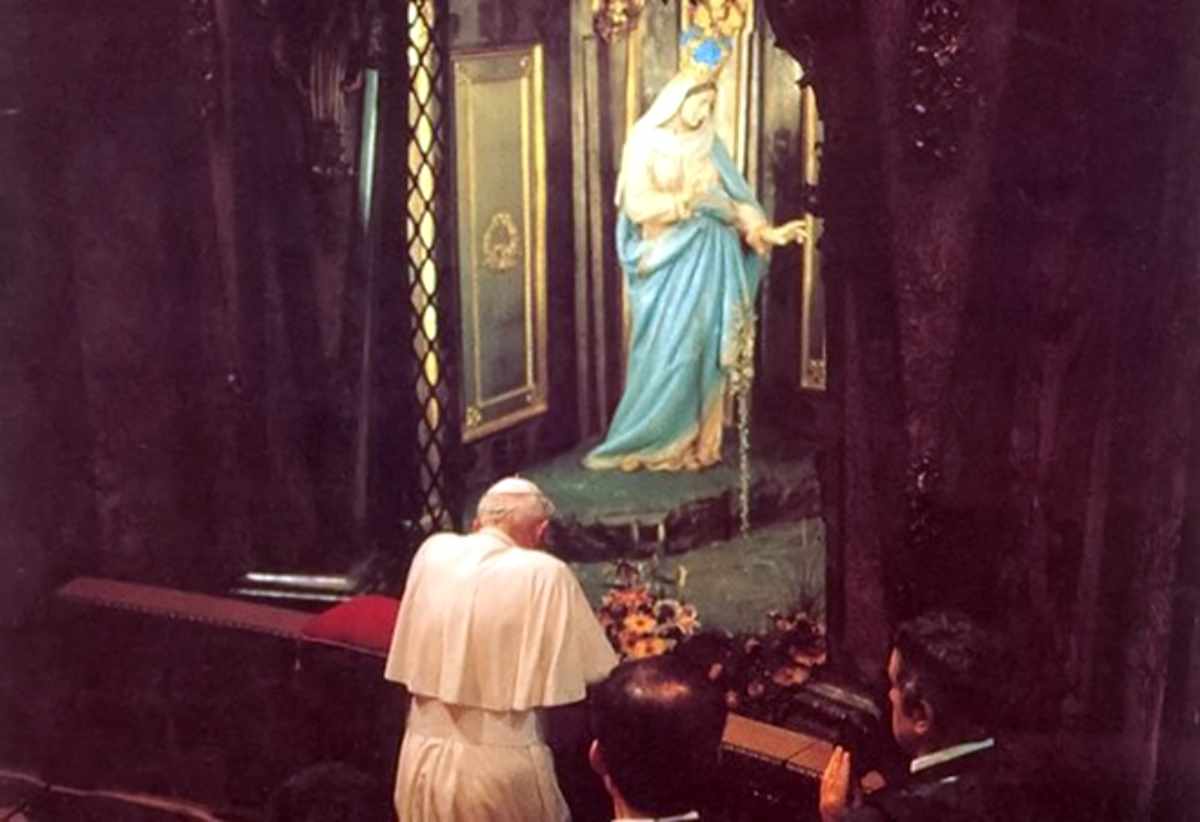
St. John Paul II visited the sanctuary in June 1992
The Sabbath of Gratitude
"I want you to say," the ancient account continues, "...that after vespers they should celebrate every Sabbath in devotion to Me. That half-day they should dedicate it to Me for the many and great favors they have obtained from My Son through My intercession."
Even when the Virgin appears to ask for prayers, what continues to happen that is different from what happened in the first generation of disciples? "All were assiduous and concordant in prayer, together with some women and with Mary, the mother of Jesus, and with His brothers." A place to pray and celebrate the Sabbath dedicated in gratitude to the One who had interceded "for seven years" was not effectively requested by the Comparsa to Giannetta. But it seemed to the Caravaggio community that the building of a house of prayer and a place of hospitality for the sick and pilgrims was the most real testimony of thanksgiving for grace received. Its representatives therefore asked the bishop for permission to build a church and hospital: the event of the Apparition flourished in prayer and industrious charity.
So for those who accept the message of the Apparition in its entirety and consequences, the call to conversion is an invitation to faith in the God who saves, and to a faith that transforms lives. Not intimist escapism into a fearful and pessimistic spirituality; not just a return to religious practices but a passion for building up the Church in the world, but centrality restored to the suffering, the sick, and the poor in God's house and human community.
The fruit of returning to God and living love for neighbor is joy, celebration. The "grace received" through Mary's intercession rightly demands gratitude; which, however, is not a pure duty but a joy. In the Shrine, one cannot fail to sing the Magnificat "for the mercy that from generation to generation is stretched out over those who have the holy fear of God"; one cannot fail to "celebrate" the finding of those who "were lost" and have returned to the Father's house.
If Mary, the mother, together with Jesus and the disciples participates in the wedding there will be no lack of "good wine kept in store until now."
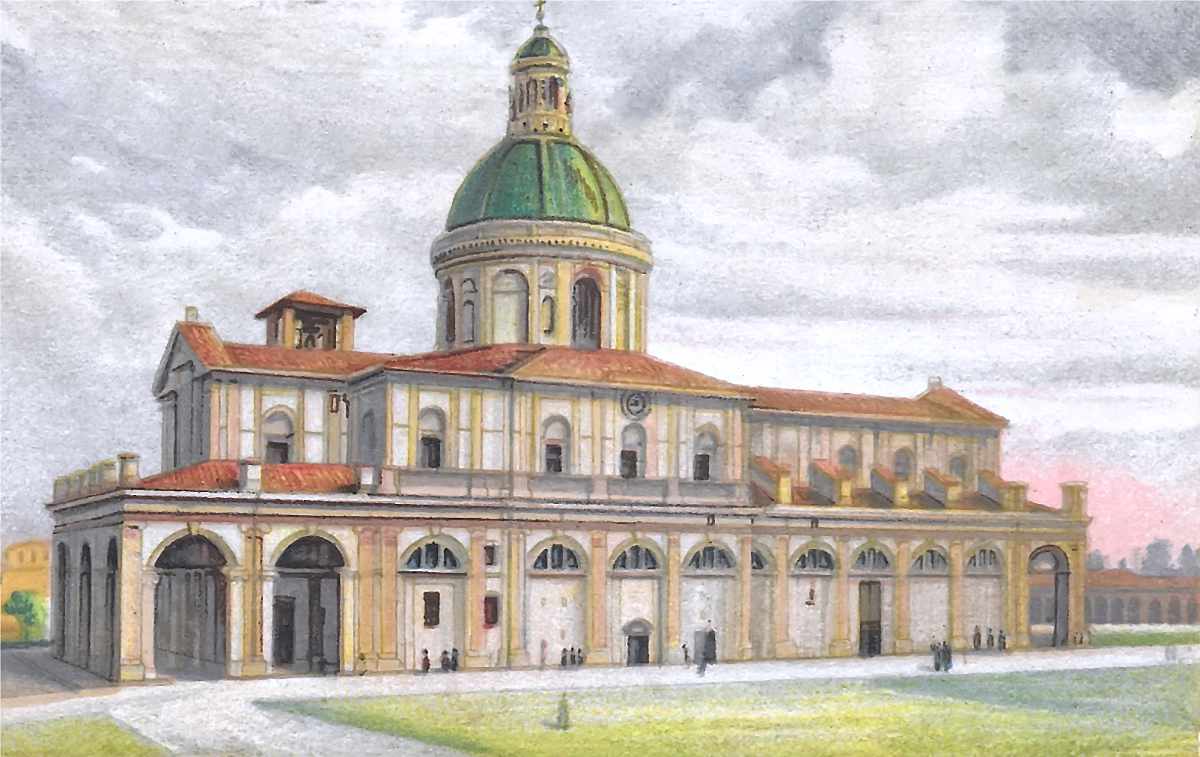
Postcard of the Sanctuary from 1948
Some Miracles
Like every sanctuary, Caravaggio has also its own history of grace. The “historical” miracles are referred to pilgrims in the underground of the Holy Fountain, thirty meters long with five cells. In the last cell there is a large Siena marble basin, where pilgrims can draw blessed water. Among the interesting episodes is the “the challenge of Graziano”. A certain Graziano, incredulous, wanted to challenge the place where Mary placed her feet.
Taking a dry branch, he planted it and immediately saw it covered with flowers and leaves.
Another episode is that of Domenico Mozzacagna. In 1520, accused of robbery, he was to be beheaded; but the executioner’s hatchet several times dropping on his neck did him not even a scratch. It was May 26th and the crowd cheered him miraculously.
On the evening of August 9, 1650 an unknown pilgrim met his arch enemy here who ran after him trying to kill him. The unfortunate sought escape in the temple which was at that moment closed. Implored the protection of Mary, the bolt of the door broke allowing the attacked man to place himself safely at the foot of the statue of the Virgin after that the door had immediately closed behind him.
Prayer to Our Lady of Caravaggio
O Most Holy Virgin of Caravaggio,
inexhaustible source of grace,
from an ancient and honored devotion,
on this day when we celebrate Your apparition,
we pray that the hope
of each one who approaches You
may not be disappointed,
and no one will remain in vain supplication.
Our Lady of Caravaggio, pray for us
O most holy Virgin of Caravaggio,
that in Your temple
and through Your patronage the blind
may return to the light of faith,
the wavering and the indolent on the Christian path
learn to walk swiftly in the way of divine commandments,
that deaf ears may open to the divine teachings,
that those who are dead from sin
may return to true life
where there is light of mind and peace of heart.
Our Lady of Caravaggio, pray for us
Anyone who turns to You to imploring You help,
O Mary, our heavenly patroness,
may we become stronger in faith,
firmer in love and so ardent with love that,
not following the enticements of evil,
we may never deflects from the right way,
O clement, O pious, O sweet Virgin Mary.
Our Lady of Caravaggio, pray for us.
Amen.
Apparitions of Jesus and Mary
The Apparition of Our Lady at Caravaggio
The Apparitions of Our Lady of the Good Event at Quito
The Revelations to Saint Margarete Mary Alacoque
The Apparitions of Our Lady at La Salette
The Apparations of Our Lady at Lourdes
The Apparition of Our Lady at Pontmain
The Apparitions of Our Lady at Pellevoisin
The Apparition of Our Lady at Knock
The Apparitions of Our Lady at Castelpetroso
The Apparations of Our Lady at Fatima
The Apparitions of Our Lord and Our Lady at Campinas
The Apparitions of Our Lady at Beauraing
The Apparitions of Our Lady at Heede
The Apparitions of Our Lady at Ghiaie di Bonate
The Apparitions of Rosa Mistica at Montichiari and Fontanelle
The Apparitions of Our Lady at Garabandal
The Apparitions of Our Lady at Medjugorje